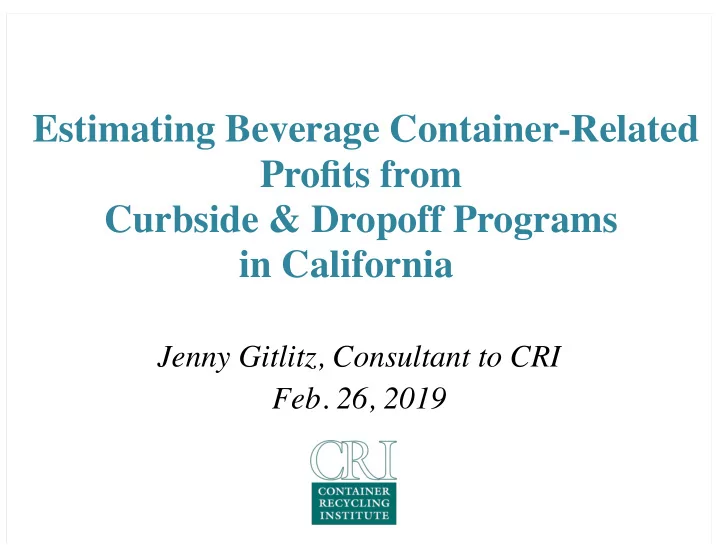

Estimating Beverage Container-Related Profits from Curbside & Dropoff Programs in California Jenny Gitlitz, Consultant to CRI Feb. 26, 2019
Revenues, Costs, and Profits
Overview: CA within larger context More than 50 container deposit programs worldwide Curbside access: Curbside access: 10 U.S. states 73% of U.S. 12 Canadian provinces population (2017) Dozens of other countries Dropoff access: Dropoff access: more prevalent in • Most deposit systems co-exist with rural areas curbside & dropoff recycling programs • Operated by separate entities • Financed differently
CRI’s recent research conducted to: Unravel complexity & explain sources of 7 different types of funding for CA curbside & dropoff programs accepting beverage containers accepting beverage containers Quantify payments : Individually and collectively Dollar-per-ton basis & total dollar basis Quantify total revenues, including estimated costs total profits
How Curbside & Dropoff are Typically Funded Fee for service: primary funding by ratepayers ratepayers or taxpayers taxpayers , with supplementary funding from Sale of recyclables State grant programs (sometimes) Hawaii & British Columbia allow curbside operators to separate deposit containers for refund monies. California is unique in having a complex and varied system of using deposit system monies to help fund curbside & dropoff recycling.
California: 5 Payments from CalRecyle 1. “CRV” deposit revenue (5¢ or 10¢ refund) 2. Administrative fees 3. Processing payments 4. Quality Incentive Payments 5. Curbside Supplemental Payments
California: Payments from Other Parties 1. Service fees from municipalities or ratepayers: per household ( i.e. monthly bill). We will not discuss these. 2. Material (scrap) revenues from the sale of recyclables (aluminum, glass, PET, HDPE.) We will discuss these.
Adjusted CRV Revenue Per Ton 5¢ or 10¢ ¾ of = A + B = C x 2,000 per unit 1% of CRV
Other State Revenue Per Ton Quality Incentive Processing Payments: Payments: Complex formula based Paid to processors to on cost of recycling and encourage clean glass past scrap values Curbside supplemental payments: paid to curbside and dropoff operators based on volume (units) collected: total of $15 $15 million million
Scrap Values Per Ton, as Surveyed by CalRecycle Aluminum Glass has price does small not vary by difference program type Dropoff plastic is more valuable: especially HDPE
Profit Per Ton Gross revenue Gross cost per ton: per ton: Profit per Surveyed by CalRecycle Adjusted CRV ton: revenue + Gross Other state revenue per revenue + ton Scrap revenue minus gross cost per ton Percentage profits: gross profit per ton divided by gross cost per ton
Profit Statewide Tons of CRV recycled: surveyed by Profit statewide: CalRecycle Tons recycled x profit per ton
Numbers are illustrative, not definitive Actual profits will vary by: program operational particulars consumer patterns material changing scrap market conditions location Use estimates as guideposts in evaluating CalRecycle’s payment mechanisms to curbside and dropoff programs.
Recommend
More recommend